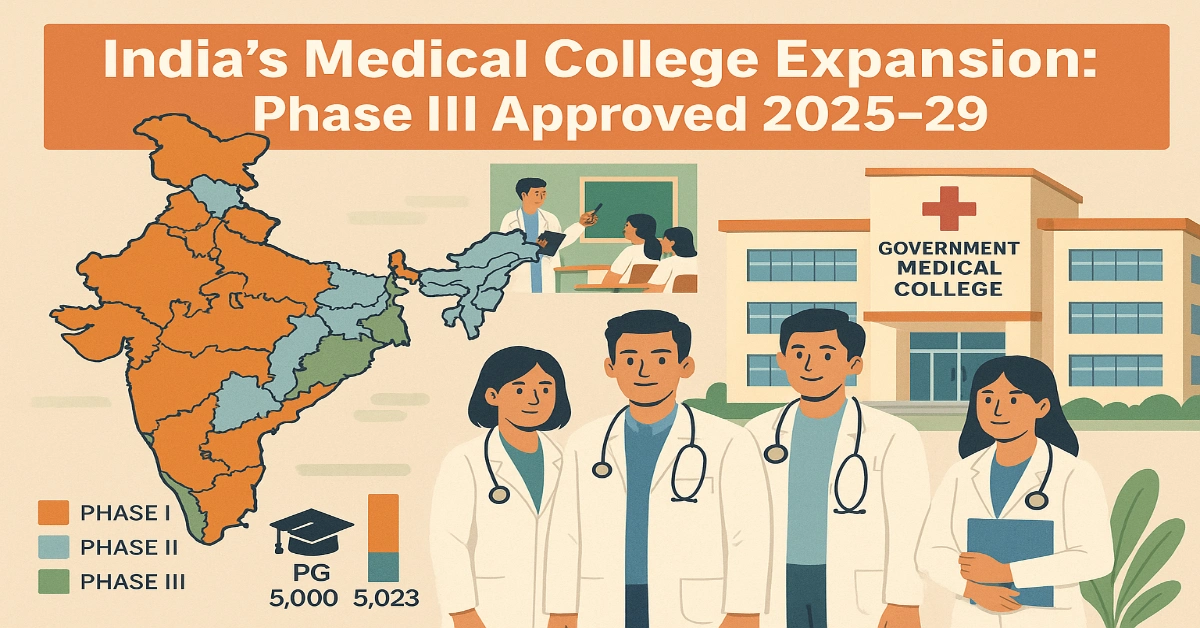Medical College Expansion in India: India’s healthcare system is at a critical juncture. The demand for doctors far exceeds supply, with millions of NEET aspirants competing for limited seats. Recognising this gap, the Government of India has pursued a multi-phase strategy under the Centrally Sponsored Scheme (CSS) to expand medical education capacity, both at the undergraduate (MBBS) and postgraduate (PG) levels.
From Phase 1 through Phase 2, the CSS has become the backbone of India’s medical education policy. Recently, the Union Cabinet approved Phase 3 to create 5,000 PG seats and 5,023 UG seats between 2025-26 and 2028-29.
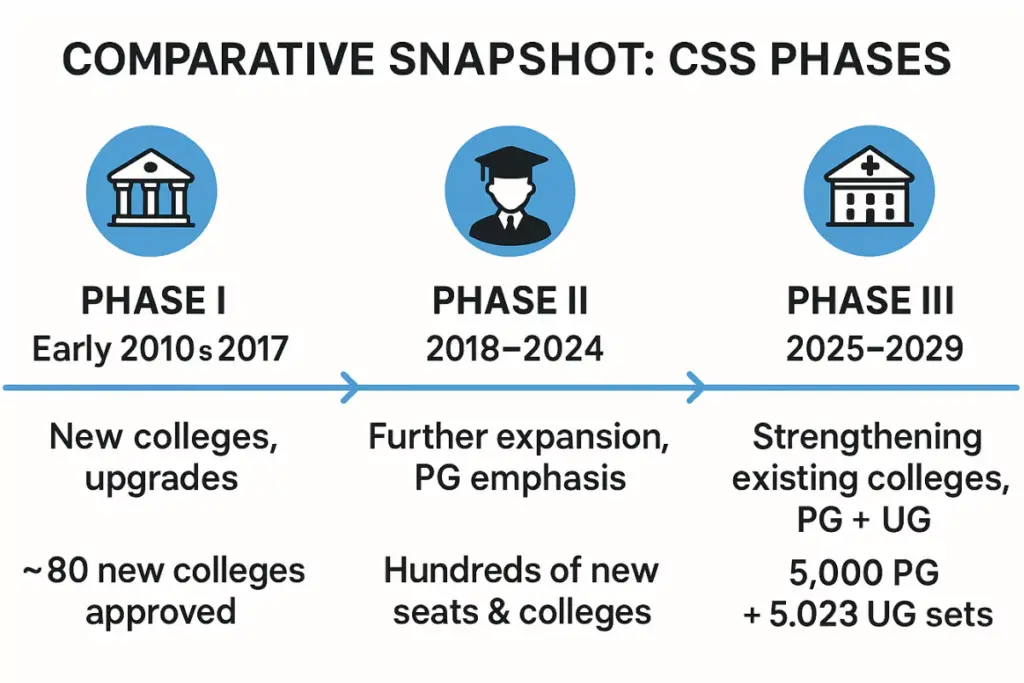
The Centrally Sponsored Scheme (CSS)
The CSS model allows the Central Government and State Governments to share the cost of expanding medical education infrastructure. This partnership enables states to leverage central funding while aligning with national healthcare priorities.
- Centre’s Role: Major funding, policy guidance, quality benchmarks.
- States’ Role: Land, co-funding, local implementation, faculty recruitment.
- Regulatory Oversight: National Medical Commission (NMC) sets standards, accredits colleges, and inspects compliance.
Implementation and Finance Model of CSS Phase 1-2-3
The Centre–State financial model:
- Funding Pattern: Roughly 60:40 Centre: State (varies by region).
- States’ Responsibility: Land, hiring faculty, and operational costs.
- Central Role: Major capital expenditure for infrastructure & equipment.
This collaborative model allows even smaller states to participate in national-level upgrades, reducing disparities.
Medical College Expansion in India
Medical education in India has undergone a dramatic transformation in the last two decades. India has adopted an ambitious policy of medical college expansion, driven by a growing population, an increasing disease burden, and millions of aspirants competing for limited medical college seats.
This expansion is part of a coordinated effort under the Centrally Sponsored Scheme (CSS) to create a stronger healthcare workforce and improve access to quality care.
Medical College Expansion in India: Scale of Growth
- Number of Medical Colleges: India now has 808 medical colleges, the largest in the world.
- Seat Capacity: Undergraduate (MBBS) seats have grown from about 54,000 in 2014 to over 1,23,000 as of now, while PG seats have also more than doubled.
- Government vs Private Balance: Nearly 50% of the total seats are in government colleges, which provide affordable education compared to private institutions.
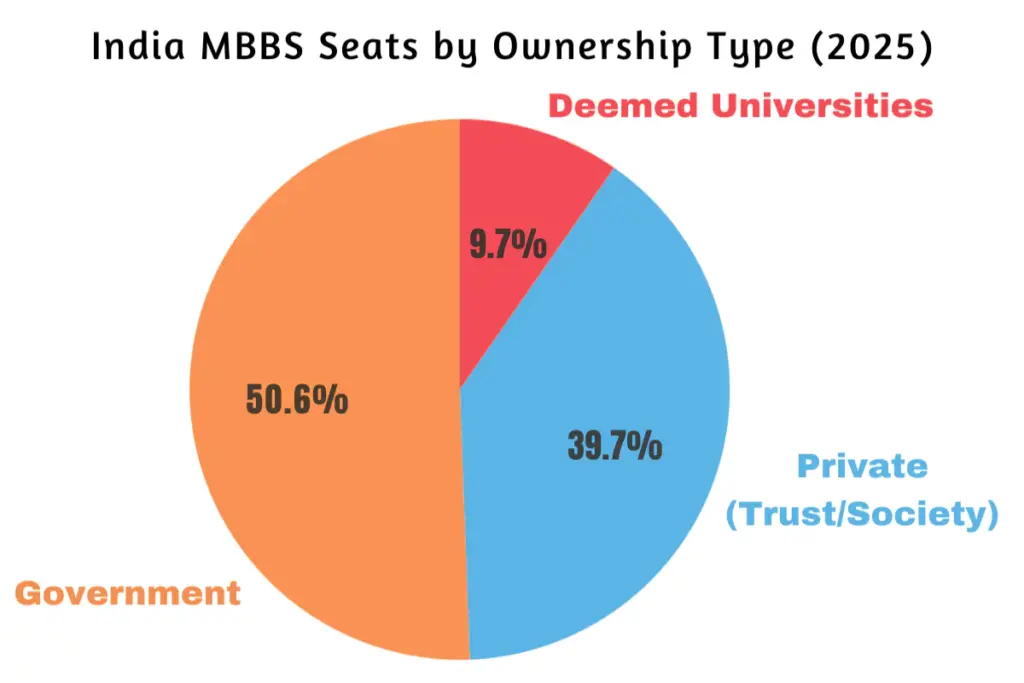
CSS Phase 1-2-3 Strategy
The expansion isn’t random; it has followed a phased, structured approach:
| Phase | Focus | Impact |
|---|---|---|
| Phase I | Establishing new colleges and upgrading district hospitals | Created capacity in underserved areas |
| Phase II | Further expansion to ensure a college in every 3 parliamentary constituencies | Expanded both UG and PG seats |
| Phase III (2025–29) | Strengthening existing government colleges to add 5,000 PG and 5,023 UG seats | Largest seat addition to date |
This phased model ensures that infrastructure, faculty, and patient load keep pace with seat increases.
Read Also: India’s Medical Education Revolution: NMC Reforms, CBME, NEXT & More
CSS Phase 1-2-3 Explained
CSS Phase 1: Laying the Foundation
The first phase of the CSS focused on establishing new medical colleges and upgrading existing ones to improve capacity. It was driven by a vision to bring a medical college to underserved regions, thus reducing geographic inequality.
Key initiatives included:
- Converting district hospitals into teaching hospitals.
- Introducing new specialties to meet local health needs.
- Prioritising states with the lowest doctor-patient ratios.
Read Also: Doctor-Patient Ratio in India Reach WHO Target: South India Leads, Rural Gaps Persist
CSS Phase 2: Consolidating the Expansion
Building on Phase I’s success, Phase 2 aimed at further increasing the availability of medical seats and strengthening regional distribution.
Highlights of Phase 2:
- Approval of additional new colleges, especially in semi-urban and rural districts.
- Goal to ensure a medical college in every three parliamentary constituencies.
- Expansion of postgraduate training capacity across government medical colleges.
CSS Phase 3: The Next Leap (2025-26 to 2028-29)
Approved in September 2025, Phase III represents the most ambitious expansion yet:
- 5,000 PG seats to strengthen specialties.
- 5,023 UG (MBBS) seats to address undergraduate demand.
- Focus on strengthening and upgrading existing government medical colleges rather than only creating new institutions.
- Introduction of new specialties to improve the availability of specialist doctors.
- Timeline: Implementation between 2025-26 and 2028-29.
Read Also: NMC MBBS Seat Matrix 2025 Released
CSS Phase 3 Financial Breakdown
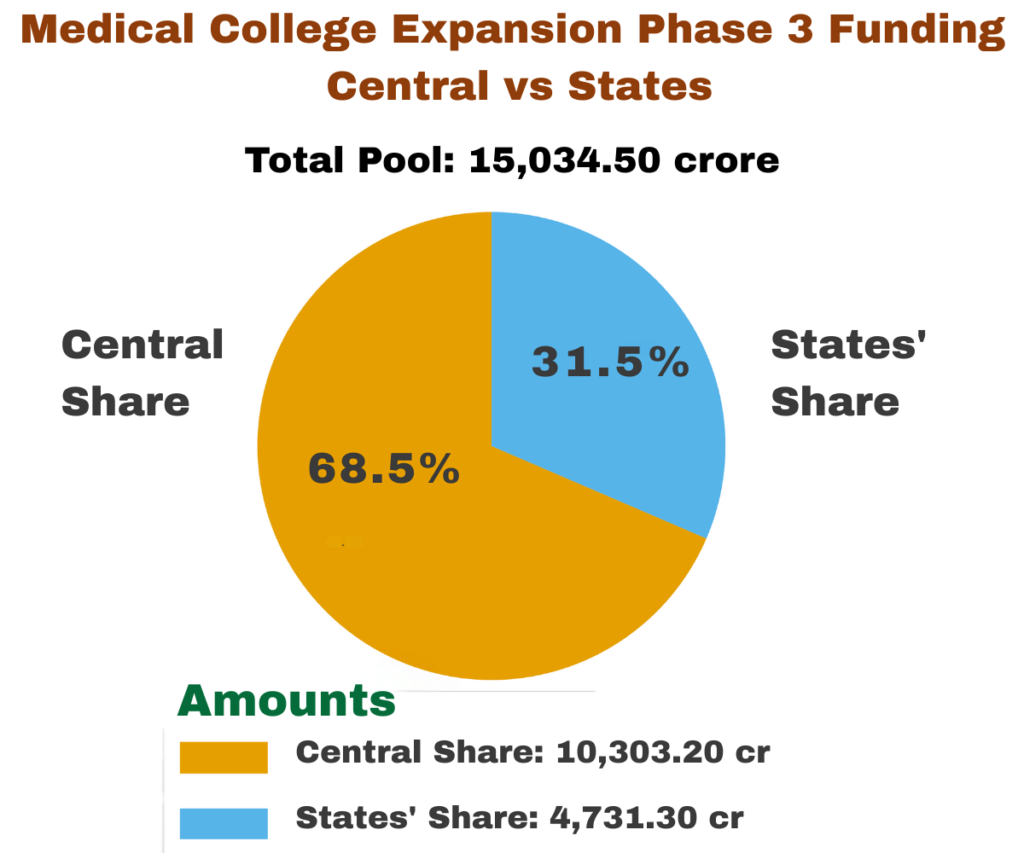
The seat creation model is designed through government medical colleges, standalone PG institutes, and associated hospitals, ensuring capacity expansion with strong institutional support.
Read Also: NMC Fee Guidelines: 50% Private Medical Seats at Govt College Fees
Key Objectives of the Expansion
| Objective | Impact |
|---|---|
| Increase Medical Seats | Meet high NEET demand; offer more MBBS and PG opportunities domestically. |
| Augment Doctor Availability | Strengthen India’s healthcare workforce, especially in rural & underserved areas. |
| Improve Access & Affordability | Government medical seats are significantly cheaper than private or overseas alternatives. |
| Address Workforce Shortages | Ensure specialist availability and reduce patient load on existing doctors. |
| Strengthen Healthcare Infrastructure | Upgrade hospitals, labs, hostels, and teaching facilities alongside seat increases. |
Addressing Faculty Shortages
One of the biggest hurdle in expanding medical education is the shortage of qualified faculty. To address this, the government and regulators have adopted measures such as:
- Mandatory attendance monitoring for teaching staff.
- Allowing DNB-qualified doctors to teach expands the talent pool.
- Raising the upper age limit for faculty recruitment.
- Introducing flexible, short-term contracts to quickly fill gaps in specialties.
Without such measures, the seat expansion risks diluting educational quality.
Read Also:
- NMC Faculty Rules 2025 Aims to Expand Medical Education in India
- AIIMS Faculty Shortage Crisis: Causes, Impact, and Solutions
- Bridging the Gaps in the Medical Education System of India
Role of the National Medical Commission (NMC)
The NMC plays a pivotal role in ensuring that the rapid expansion does not compromise standards:
- Accreditation of new seats and specialties.
- Regular inspections to verify infrastructure, faculty, and patient load.
- Standardising curriculum and assessments across states.
- Promoting transparency in seat allocation and compliance with norms.
Also Read:
- NMC Chairman Proposes AI Integration and 1:1 MBBS-PG Seat Ratio for Medical Education 2025
- NMC MARB Guidelines 2024: How to Start a New Medical College & Increase MBBS Seats in India
Why Medical College Expansion Matter?
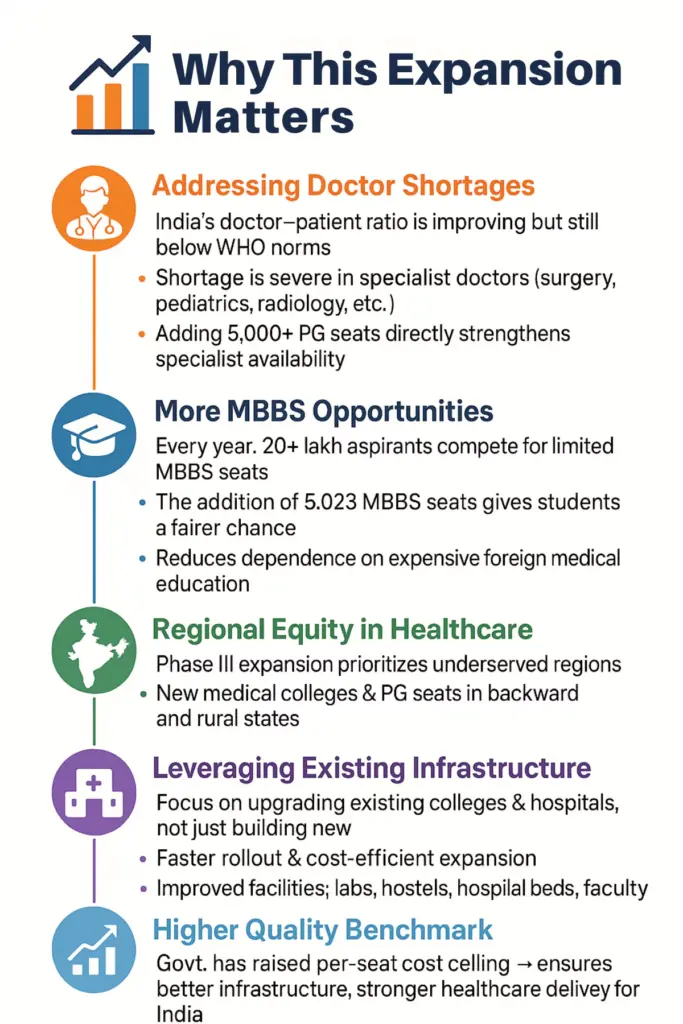
Read Also: Monopoly in Medical Education in India: Ownership, Costs & Reforms 2025
Medical College Expansion in India: Challenges & Risks
Despite the impressive numbers, there are several clallenges to Medical College Expansion, whic we have to tackle.
This plan faces major hurdles:
| Challenge | Implications |
|---|---|
| Faculty Shortage | Medical colleges already face shortages of qualified professors, especially in super-specialties. Without a recruitment plan, quality may slip. |
| Infrastructure Bottlenecks | Expanding seats requires parallel expansion of labs, OPD/IPD capacity, clinical material, hostel facilities, and simulation centres. |
| Quality vs. Quantity | Mere seat increase without upgrading clinical exposure risks creating under-trained doctors. |
| Regulatory Oversight | The National Medical Commission (NMC) must conduct stricter inspections to ensure standards for new seats. |
| Execution Delays | Land acquisition, tender processes, and fund release can delay the rollout beyond 2028-29. |
| Unequal Distribution | States with stronger administrative capacity may corner more seats while weaker states lag behind. |
Read Also: History of Medical Education in India: Ancient to Modern Reforms
In a press note release, India Expands Medical Education, government of India highlighted the decision.
The Union Cabinet’s approval of Phase 3 of the Centrally Sponsored Scheme, adding 5,000 PG and 5,023 MBBS seats, is a landmark policy move. With ₹15,034.50 crore allocated, this initiative promises to transform India’s medical education landscape.
But the real challenge lies in implementation quality, infrastructure readiness, and equitable distribution. Without tackling faculty shortages, regulatory compliance, and timely execution, the expansion risks becoming a numbers game rather than a quality revolution.
For students and healthcare stakeholders, this is a time of opportunity, but also of vigilance. Tracking announcements, scrutinizing how states utilize these funds, and advocating for better quality standards will ensure that this historic expansion delivers on its promise.

